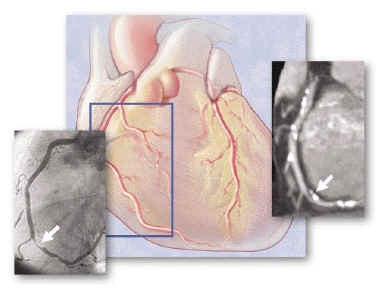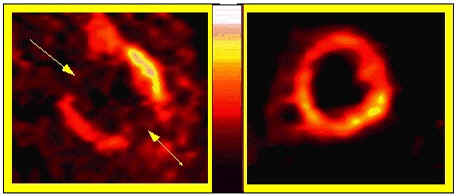
Heart Imaging
Introduction
Heart scans are used to examine the flow of blood to the heart muscle and how well the heart pumps the blood. Thallium, technetium and isonitrol are used to obtain information about the blood flow to the heart known as "perfusion". Multiple gated accquisition (MUGA) and radionuclide angiocardiography (RNA) tests utilise different radioisotopes to examine the dynamics of the heart.
Perfusion Studies
These tests are very accurate
at
detecting partial or total blockages of the coronary arteries which cause a
decrease of blood flow and oxygen
to the heart. The radioisotope is given
to the patient intravenously and accumulates in the heart in proportion to the
oxygenated blood and nutrients being delivered to the heart. A comparison
can then be made of the level of uptake in various parts of the heart.
For example, the isotope does not accumulate in areas of scar tissue since it
can only be taken up by living tissue. 
The scans can be performed at rest or by putting stress on the heart such as by exercising on a treadmill. The radionuclide is injected during the exercise or just before the images are taken. Usually a second set is taken 4 hours later after the procedure has been repeated.
MUGA Scans
In this procedure a sample of blood is taken and mixed with a radioisotope which binds to the surface of the red blood cells. The labelled blood sample is then injected intravenously and the heart is imaged by a gamma camera during rest and exercise. The best way of imaging the heart during exercise is to have pedals positioned so that patient can effectively cycle whilst lying on their back. This scan is employed to check if the heart valves are leaking or if they are too stiff.
PET Scans
The advantage of PET scans is their versatility and as in the previous tests mentioned can be carried out during exercise as well as at rest. However, PET scans can also examine heart function via the metabolism where radiolabelled glucose and insulin, a hormone controlling the metabolism of sugar, can be given intravenously. Although, PET scans are more expensive than the other scans above due to metabolic studies the extra cost is worthwhile since it provides a better picture of heart function.

www.heartcenter.com/nuclear.html
www.mayo.edu/cv/wwwpg_cv/nuc_lab/scans.html
Heart PET scan: www.biomed.org/pet.html